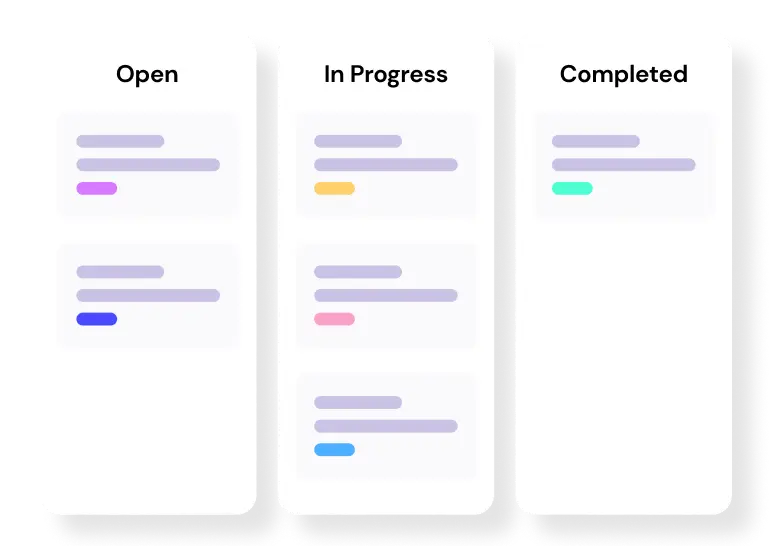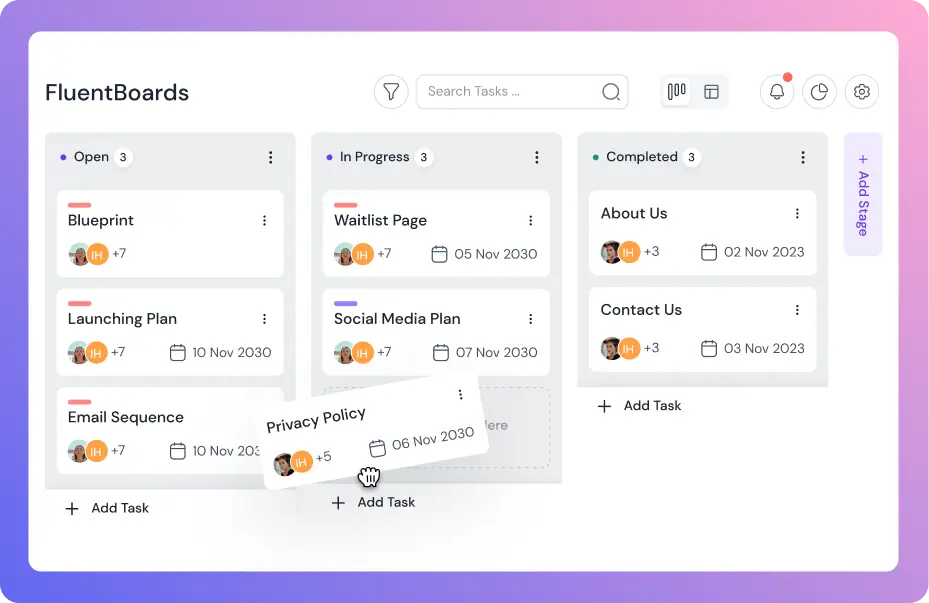
20+ Proven Project Management Tips: Navigate Every Project Phase with Confidence!
Ever started a project feeling excited but quickly realized it’s way more challenging than you expected?
Well, you’re not alone!
We’ve all been there and we might even feel that way in our next project too!
But, fortunately, through our experiences with various projects (including the FluentBoards launch), we’ve uncovered some rock-solid project management tips and hacks that can make the journey a lot smoother.
Curious to discover them?
Let’s start by refreshing our understanding of the basics!
What is Project Management?
Project management involves planning, organizing, and managing projects to meet specific objectives. Simply put, project management is about using the right knowledge, skills, and tools to complete a project successfully.
It ensures projects are completed –
- On-time,
- Within budget
- And, meet stakeholder expectations
However, the importance of project management goes far beyond these three aspects. With the right strategies in place, you can overcome any project management challenges by fostering an environment where everyone works toward the same goal—strategically and collaboratively.
20+ Proven Project Management Tips!
Every project goes through several distinct phases—initiation, planning, execution, monitoring, and closure. To ensure your project concludes successfully, you must have well-defined strategies for each stage.
And, for your convenience, we’ve organized tips for every phase of project management!
Let’s dive in!
Tips for a strong project initiation
The initiation stage of any project can be perfectly described by Socrates’ famous quote: “Know thyself!”
It’s all about understanding strengths, objectives, motivations, and most importantly, limitations.
So,
1. Start with the basics
Begin by understanding the essentials. Ask, answer, and understand:
- What is the project about?
- What is its purpose?
- What will you achieve by the end?
Clear answers to these questions will set a strong foundation for your project. However, if you’re still unsure where to start, project management books can guide you forward with clarity and confidence.
2. Identify stakeholders
Stakeholders are people or groups who care about the project’s outcome and can affect its success.
And, to make your project successful, it’s important to identify them. Divide them into groups like primary stakeholders, secondary stakeholders, and key decision-makers.
3. Engage stakeholders early
It’s smart to include all key stakeholders in discussions from the beginning.
Understand your client’s expectations, take your team’s ideas into account, and most importantly, have open conversations!
4. Check feasibility before you start
Imagine you’ve made a plan and started working hard, only to realize halfway that it’s not possible. Irony, right?
That’s why it’s important to run a quick feasibility test.
Assess the technical, financial, and operational aspects of the project to determine if it’s viable.
5. Decide which tool you’ll use
There are many project management tools to make your job easier, but the problem is, that each one offers different features and has different priorities.
So, it’s important to choose the right tool.
We suggest picking one that has the features you need, is easy to use, and is cost-effective. If you’re using WordPress, choose a tool specifically built for WordPress.

Level up your WordPress project management game with this Trello equivalent solution – where limitless possibilities come at an unbeatable price!
Tips for strategic project planning
Here comes the most important phase of a project!
Because solid execution starts with flawless planning. Just like the famous proverb says, “As you sow, so shall you reap.”
So,
6. Develop a detailed project plan
First thing first, gather all the discussions from the previous phase, including the goals you want to achieve, when and how you plan to achieve them, and any obstacles.
Put everything on the same page, and then start creating a detailed plan.
Next, develop a comprehensive roadmap that outlines tasks, timelines, and responsibilities based on your findings. If possible, create a primary to-do list to keep everything organized and on track.
7. Identify risk factors
To battle the challenges, you first need to identify them.
Remember, just because problems aren’t immediately visible doesn’t mean they don’t exist!
So, turn on your detective mode! Look closely, uncover hidden risk factors, and plan how you will address them.
8. Ensure flexibility
Just because you’ve spent enough time identifying risk factors doesn’t mean you should be overconfident!
Many more challenges may arise during the project execution phase that you might not be aware of!
That’s why it’s important to ensure there is enough breathing room in your project so you can adjust accordingly.
9. Assess resource availability
If you are running an organization, there’s a good chance that many projects are ongoing at the same time. This means a portion of your potential resources—whether human or otherwise—are already invested.
Therefore, it wouldn’t be wise to make a plan based on your total workforce or resources.
So, first, identify the resources available to you. Understand your teammates’ strengths and weaknesses, and determine which team organizational structure would be the most suitable for them to adopt.
10. Establish a communication plan
From planning to execution and ultimately a successful project, the entire journey depends largely on one critical factor—effective communication!
The more precise your communication, the smoother your project team management will be!
So, decide early on your meeting procedures, real-time communication channels, and how often you’ll meet with stakeholders and team members.
These precautions will help you deal with unwanted threats like scope creep.
Tips for smooth project execution
Hold on tight—we’re about to take off! Jokes aside, the project execution phase is literally like this, and it’s where the real game begins!
So, be cautious and follow these tips:
11. Define project goals & objectives
Aligning everyone involved in the project is essential for its success.
It’s important to introduce everyone to the project goals and project objectives and goals so they know what the team is trying to achieve.

That’s why it’s recommended to keep these objectives documented and easily accessible for all.
This ensures that everyone, whether involved from the start or joining halfway, can quickly understand the objectives, goals, and working procedures at a glance.
12. Break the project into pieces
Oh God, so much to do—how will it all get done?
Well, that’s probably the first thought that crosses anyone’s mind when they start working on a project!
That’s why it’s wise to break away from the traditional approach and bring some fun into the process.

Turn project execution into a puzzle-solving game! Break the entire project into bite-sized tasks, tackle each one, and, in the end, connect all the pieces to achieve a successful project.
13. Assign the right members
Effective collaboration is important for ensuring all your efforts yield the expected results.
That’s why, move forward as a team by assigning clear roles and responsibilities. Be cautious not to overburden anyone. Just because someone is good at everything doesn’t mean you should overextend their abilities.

Instead, proceed strategically so that by the end of the project, you not only achieve success but also build a dynamic team with valuable expertise.
Here are some proven project team collaboration tips
14. Set priorities
Yes, every task in a project is important, but their significance can differ, right?
Some tasks need to be completed urgently, while others can take more time. Additionally, there may be interdependent tasks that affect one another. That’s why identifying these distinctions upfront is crucial.

So, sort your tasks based on priority, assign due dates for each one, and move forward in an organized manner.
15. Onboard other stakeholders
Say goodbye to traditional project management and adopt a process where everyone stays connected and informed!
Your clients or end users play a crucial role in your project, especially if you’re running a software business. It’s smart to onboard them into the process, allowing everything to unfold right before their eyes.
Enable them to monitor project progress, suggest necessary modifications, and act accordingly.

FluentRoadmap Comes Free with FluentBoards Pro!
16. Communicate clearly
Speak your mind clearly!
Remember, it’s the nucleus of collaboration skills, and great teamwork starts with it!
So, precisely let your team members know what you want and exactly when you want it. It’s even better if you use a tool that facilitates real-time communication.

Additionally, make sure your team never misses anything important. In this case, email notifications can be your secret weapon.
17. Lead from the front and infuse accountability
As a leader, you shouldn’t just command—you should act. Make sure you’re contributing significantly to the project.
To instill accountability, create a system where everyone is aware of each team member’s contributions. This helps show that it’s a team effort, not a one-person show.
Tips for streamlined project monitoring
Success—the sweet reward we all celebrate—but was the journey ever easy?
Never! To achieve success, you need to keep everything on track. No detail should go unnoticed, and when we ensure this, the magic happens!
So,
18. Set clear milestones
Break your project into smaller milestones and decide the KPIs of the project. This makes it easier to track progress and allows you to make adjustments before things go off track.
Keep a close eye on these milestones to see if you’re achieving them within the expected time frame. When a milestone is reached, consider throwing a small celebration to keep the team motivated for the next one!
19. Use a real-time dashboard
Leverage project management tools with real-time dashboards to keep track of every aspect of the project, including deadlines, tasks, and team performance.

Besides, don’t forget to constantly track KPIs relevant to your project’s success. These could include budget, time, resource allocation, and task completion rates.
20. Conduct regular meetings
To move forward in an organized and informed manner, conducting regular meetings can be invaluable.
First, set an interval for how often you want to meet. Discuss openly with your team about project progress, the challenges they are facing, what approaches are working, and what should be modified. This allows you to address potential issues early.
Additionally, consider meeting with other stakeholders from time to time. This keeps them informed and makes them feel valued.
21. Stay flexible
Be open to adjustments. If something isn’t going as planned, don’t hesitate to adapt to new conditions to keep the project on track.
Tips for smooth project closure
It’s not over until it’s truly over!
We know every successful project deserves a celebration, and we’re not stopping you from that. We’re just reminding you to check some essentials before you start the party.
22. Conduct a final review
Hold a meeting with your team to review the project’s objectives, outcomes, and any deviations from the original plan.
This will help you evaluate how well the execution went and identify any shortcomings.
23. Document everything
Compile all project documentation, including reports, decisions made, and lessons learned. This documentation can be invaluable for future projects.
Additionally, sharing it with clients helps ensure accountability and fosters trust for future collaborations.
24. Gather feedback
Collect feedback from your team and stakeholders. Understand what worked well and what could be improved for future projects.
This promotes continuous improvement.
Navigate Your Projects with Confidence
That’s all for today! We hope the project management tips we shared will help you tackle your next project with confidence.
Remember, every project is an opportunity to learn. Embrace the challenges with open arms, tackle them strategically, learn throughout the process, and celebrate your successes.
Thank you for reading this far! Don’t forget to leave your thoughts in the comments. We appreciate your feedback!
Let’s redefine project management with FluentBoards!
Get Tips, Tricks, & Updates
We won’t send you spam.









![how to create a project management workflow [x steps] (2)](https://fluentboards.com/wp-content/uploads/2025/11/How-to-create-a-project-management-workflow-x-steps-2-768x402.webp)





Leave a Reply